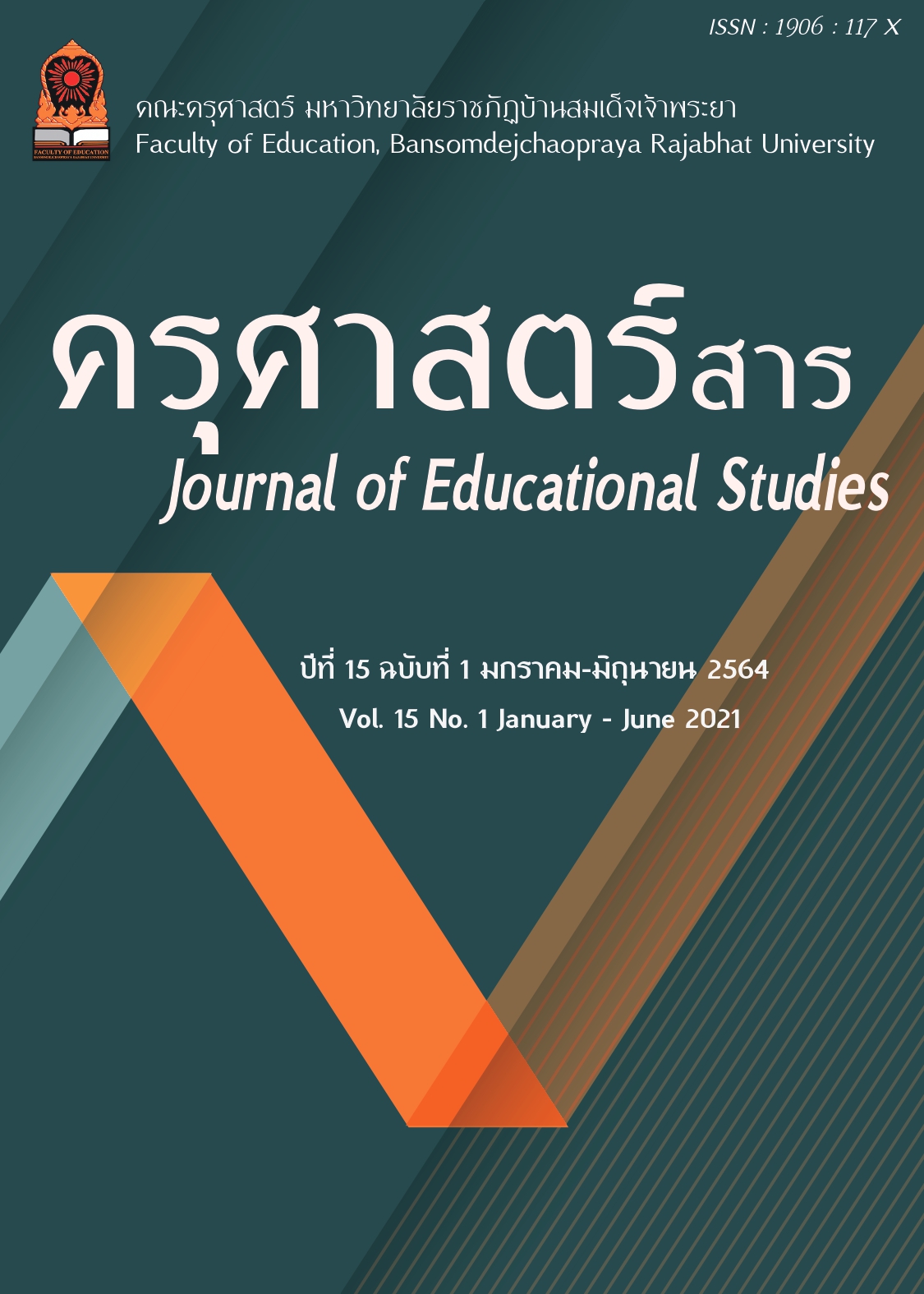วารสาร
การพัฒนาเครื่องมือวัดพฤติกรรมการเรียนรู้ของนักเรียนในยุคเทคโนโลยีเปลี่ยนแปลงอย่างฉับพลัน
วนัชพร ถาวรสมสุข
จุฬาลงกรณ์มหาวิทยาลัย
ดวงกมล ไตรวิจิตรคุณ
จุฬาลงกรณ์มหาวิทยาลัย
บทคัดย่อ
การวิจัยนี้มีวัตถุประสงค์การวิจัย คือ (1) เพื่อสังเคราะห์องค์ประกอบของพฤติกรรมการเรียนรู้ของนักเรียนในยุคเทคโนโลยีเปลี่ยนแปลงอย่างฉับพลัน โดยใช้การศึกษาเอกสารและงานวิจัยที่เกี่ยวข้องด้วยแบบบันทึกข้อมูลเพื่อให้ได้องค์ประกอบที่จะนำไปสร้างเครื่องมือวัดต่อไป (2) เพื่อพัฒนาและตรวจสอบคุณภาพเครื่องมือวัดพฤติกรรมการเรียนรู้ของนักเรียนในยุคเทคโนโลยีเปลี่ยนแปลงอย่างฉับพลัน ตัวอย่างวิจัย คือ นักเรียนระดับชั้นมัธยมศึกษาตอนปลายจำนวน 322 คน โดยเก็บข้อมูลด้วยแบบวัดพฤติกรรมการเรียนรู้ของนักเรียนที่ผู้วิจัยพัฒนาขึ้น เพื่อตรวจสอบคุณภาพของเครื่องมือในด้านความตรงเชิงเนื้อหา ความเที่ยง และ ความตรงเชิงโครงสร้าง ผลการวิจัยพบว่า 1. องค์ประกอบของพฤติกรรมการเรียนรู้ของนักเรียนในยุคเทคโนโลยีเปลี่ยนแปลงอย่างฉับพลันประกอบด้วย 4 องค์ประกอบ ได้แก่ การใช้เทคโนโลยีในการเรียนรู้ การเรียนรู้ด้วยการศึกษาแบบเปิด การเชื่อมโยงกับเครือข่ายสังคม และ ความยืดหยุ่นในการเรียนรู้ 2. แบบวัดพฤติกรรมการเรียนรู้ของนักเรียนในยุคเทคโนโลยีเปลี่ยนแปลงอย่างฉับพลันมีลักษณะเป็นมาตรประมาณค่า 5 ระดับ จำนวน 15 ข้อ ที่พัฒนาขึ้น มีคุณภาพด้านความตรงเชิงเนื้อหา คือค่า IOC ข้อคำถามทุกข้ออยู่ในระดับที่เหมาะสมมีค่าอยู่ระหว่าง 0.67 – 1.00 มีคุณภาพด้านความเที่ยงโดยค่าสัมประสิทธิ์แอลฟาของครอนบาค (Cronbach’s alpha coefficient) ของทุกองค์ประกอบมีค่าอยู่ในเกณฑ์ที่ยอมรับได้ (α = .695 - .785) และมีความตรงเชิงโครงสร้าง โดยใช้การวิเคราะห์องค์ประกอบเชิงยืนยัน (confirmatory factor analysis) พบว่ามีความสอดคล้องกับข้อมูลเชิงประจักษ์ (χ2 (2, N = 322) = 1.024, p = .599, CFI = 1.00, BIC = 1.00, RMSEA = .000, SRMR = .009)
Abstract
This research aimed to (1) synthesize components of students’ learning behavior in disruptive technology age. By using the study of related documents and research with the data sheet in order to obtain the components that used for design the measures; (2) to develop and validate the quality of students’ learning behavior in disruptive technology age measures. The samples were 322 upper secondary students. The data was collected by the students’ learning behavior measures developed by the researcher. To examine the quality of the measures in terms of their content validity, reliability and construct validity. The research findings were as the followings: 1) The component of students’ learning behavior in disruptive technology age consists of four components included using technology in learning, learning with open education, connecting to social networks and learning flexibility. 2) The students’ learning behavior in disruptive technology age measures was a five-level rating scale of 15 items that were developed with the quality of content validity by IOC, all questions are at appropriate levels. Between 0.67 - 1.00 The quality of reliability with Cronbach's alpha coefficient of all component being acceptable. (α = .695 - .785) And the construct validity using confirmatory factor analysis was found to be casual fitted well with empirical data. (χ2 (2, N = 322) = 1.024, p = .599, CFI = 1.00, BIC = 1.00, RMSEA = .000, SRMR = .009)
คำสำคัญ
พฤติกรรมการเรียนรู้ของนักเรียน, เครื่องมือวัดพฤติกรรมการเรียนรู้ของนักเรียน
Keywords
Students’ learning, Students’ learning Measures
เอกสารอ้างอิง
ศิริชัย กาญจนวาสี. (2558). ทฤษฎีการประเมิน. กรุงเทพมหานคร : โรงพิมพ์แห่งจุฬาลงกรณ์มหาวิทยาลัย.
Bassiouni, D., & Hackley, C. (2014). Generation Z children’s adaptation to digital consumer culture: A critical literature review. Journal of Customer Behaviour 13(2), 113-133. https://doi.org/10.1362/147539214X14024779483591
Bavelier, D., Green, C. S., & Dye, W.G. M. (2010). Children, Wired: For better and for worse. Neuron, 67(5), 692-701. https://doi.org/10.1016/j.neuron.2010.08.035
Christensen, C. M., Horn, M. B., Caldera, L., & Soares, L. (2011). Disrupting college: How disruptive innovation can deliver quality and affordability to postsecondary education. Innosight Institute. https://www.americanprogress.org/issues/economy/reports/2011/02/08/9034/disrupting-college/
Consultancy.uk. (2015). Generation Y less satisfied than other generations. https://www.consultancy.uk/news/2061/generation-y-less-satisfied-than-other-generations
Choi, M., Glassman, M., & Cristol, D. (2017). What it means to be a citizen in the internet age: Development of a reliable and valid digital citizenship scale. Computers & Education, 107, 100-112. https://doi.org/10.1016/j.compedu.2017.01.002
Farrell, W. C., & Phungsoonthorn, T. (2020) Generation Z in Thailand. International Journal of Cross Cultural Management, 20(1), 25-51. https://doi.org/10.1177/1470595820904116
Flavin, M. (2012). Disruptive technologies in higher education. Research in Learning Technology, 20, 102-111. https://doi.org/10.3402/rlt.v20i0.19184
Flavin, M. (2016). Technology-enhanced learning and higher education. Oxford Review of Economic Policy, 32(4), 632-645. https://doi.org/10.1093/oxrep/grw028
Gracia, M. (2019). Effects of educational technology integration in classroom instruction to the math performance of gen z students of a private high school. Researchgate.
https://www.researchgate.net/publication/333887501
Hedberg, J. G. (2011). Towards a disruptive pedagogy: Changing classroom practice with technologies and digital content. Educational Media International, 48(1), 1-16. https://doi.org/10.1080/09523987.2011.549673
Henderson, M., Selwyn N. & Aston, R. (2017). What works and why? student perceptions of ‘useful’ digital technology in university teaching and learning. Studies in Higher Education, 42(8), 1567-1579, https://doi.org/10.1080/03075079.2015.1007946
Horvath, I. (2016). Disruptive technologies in higher education. Proceedings of 7th IEEE International Conference on Cognitive Infocommunications (CogInfoCom), Poland, 000347-000352. https://doi.org/10.1109/CogInfoCom.2016.7804574
International Society of Technology in Education. (2008). IST standards teachers. https://id.iste.org/docs/pdfs/20-14_ISTE_Standards-T_PDF.pdf.
La Roche, C. R., & Flanigan, M. A. (2012). student use of technology in class: engaged or unplugged?. Journal of College Teaching & Learning (TLC), 10(1), 47-54. https://doi.org/10.19030/tlc.v10i1.7537
Mohd Nor, N., Nambiar, R., Ismail, K., Adam, S. (2018). Effect of redesigned classroom on secondary students’ learning behaviour. Arab World English Journal, 9(3), 17-32. https://dx.doi.org/10.24093/awej/vol9no3.2
Nowell, S. D. (2014). Using disruptive technologies to make digital connections: stories of media use and digital literacy in secondary classrooms. Educational Media International, 51(2), 109-123. https://doi.org/10.1080/09523987.2014.924661
Rothman, D. (2016). A tsunami of learners called Generation Z. Mdel.
https://mdle. net /Journal/A_Tsunami_of_Learners_Called_Generation_Z.pdf
Schmida, R. & Petko, D. (2019). Does the use of educational technology in personalized learning environments correlate with self-reported digital skills and beliefs of secondary-school students?. Computers & Education, 136, 75-86. https://doi.org/10.1016/j.compedu.2019.03.006
Soper, D.S. (2017). A-priori Sample Size Calculator for Structural Equation Models [Software]. Available from http://www.danielsoper.com/statcalc/calculator.aspx?id=89
Wastiau, P., Blamire, R., Kearney C., Quittre, V., de Gaer, E. V., Monseur, C. (2013). The use of ICT in education: a survey of schools in Europe. European Journal of Education, 48(1), 11-27. https://doi.org/10.2307/23357043
